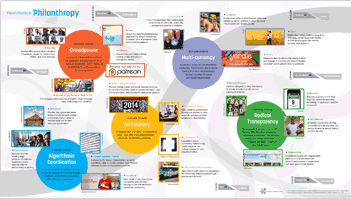Future of Philanthropy

Future of Philanthropy
Exploring a World of Networked Action for Social Impact
We find ourselves today in a period of unusual turbulence. There is uncertainty in all sectors of our economy and society. For 250 years, we’ve been steeped in a framework of production where most value creation and resources were concentrated and flowed through large hierarchical institutions: banks, corporations, foundations, large universities. We call this the First Curve and see this mode of production as slowly declining, with its descent undermining the relevance of many traditional institutions, including philanthropic ones.
 Today’s social innovators are pioneering new sets of behaviors, practices, and technology usage patterns. They are building the Second Curve—a new, highly-networked, emergent, and fluid way of organizing activities and creating value. It is a curve on which “amplified individuals”—people and small groups empowered with technologies and connections with each other—can do the kinds of things previously only large organizations, or no organization, could accomplish. And often they can do this with little or no money, limited management, and by defying traditional metrics and processes.
Today’s social innovators are pioneering new sets of behaviors, practices, and technology usage patterns. They are building the Second Curve—a new, highly-networked, emergent, and fluid way of organizing activities and creating value. It is a curve on which “amplified individuals”—people and small groups empowered with technologies and connections with each other—can do the kinds of things previously only large organizations, or no organization, could accomplish. And often they can do this with little or no money, limited management, and by defying traditional metrics and processes.
This map is both a guide and a provocation. We hope philanthropic organizations will use it to prepare for and shape a more desirable future for their constituents and stakeholders. We also hope that social innovators and communities will use it to help amplify their efforts and achieve greater impact. The Second Curve isn’t only about re-engineering organizations—it’s about building whole new ecosystems of platforms, tools, and strategies that can enable massive movements for public good. The question isn’t just when to make the leap from the First Curve to the Second Curve, but how.
Host a Remaking Philanthropy Workshop
How can you use foresight to gain insights that will enable you to make better, more impactful decisions today?
Our Remaking Philanthropy Workshop will immerse your organization in the future and help you build new pathways toward greater resilience and innovation. IFTF's forecasting and facilitation can help your organization:
- Think broadly to gain an “outside-in” perspective on long-term forces and trends shaping the future
- Anticipate opportunities for new impact and service offerings
- Gain agile positioning by questioning your assumptions and systematically considering alternative futures
- Jump-start strategic thinking by immersing you in future possibilities and identifying flexible long-term actions
- Prototype new offerings that leverage your expertise while aligning with the future
In the News
- Stanford Social Innovation Review, "Second Curve Philanthropy," by Marina Gorbis (December 1, 2014)



